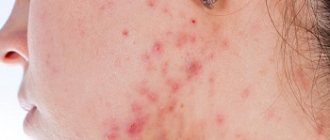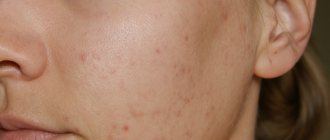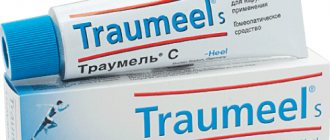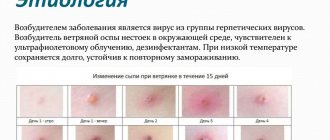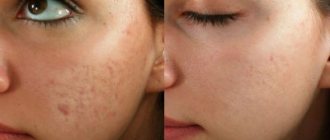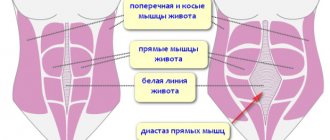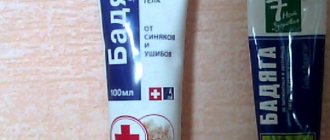Scars after chickenpox: will there be or not?
Whether there will be skin defects after the disease depends on the timely start of treatment and the correct use of ointments (gels).
Scars after chickenpox usually result from scratching the rash until it bleeds. When pyogenic bacteria are introduced under the skin, the deep layers of the epidermis are injured.
Modern ointments, which have anti-inflammatory properties, antibacterial and antiviral effects, significantly reduce the intensity of itching and instantly destroy the infection. This means they save you from further formation of scars, large pits, and scars.
To avoid the appearance of deep, large pockmarks, the rash should be lubricated immediately.
Prevention of scars after chickenpox
The scar after chickenpox appears mainly as a result of scratching the pimple. Therefore, you first need to remove the itching using special medications:
- Fenistil gel;
- Zinc ointment;
- Gistan;
- Viferon;
- Poksklin and others.
Procedures aimed at treating suppuration and preventing their occurrence are also important. The following actions contribute to the rapid healing of wounds:
- With the help of antiherpetic ointments and gels, the virus in the vesicle is destroyed.
- Pimples are lubricated with antiseptic agents.
- For suppuration, use antibacterial ointments.
What to do to avoid scars on your face and body after chickenpox
We list the names of highly effective drugs and the main rules for relieving rashes with various drugs.
What to smear
In the acute stage of the rash, it is necessary to immediately lubricate it with antiviral agents. They suppress the activity of virions and prevent penetration into skin cells.
Virus-inactivating ointments
It is necessary to treat 4-5 times a day not only the elements of the rash, but also the adjacent areas of the skin around.
- Gerpevir. The active ingredient is Acyclovir. The ointment is approved for use from 3 months of age onwards.
- Viferon. Contains recombinant human interferon. Chickenpox can be treated from the first days of birth.
- Zovirax. The cream is based on Acyclovir. Allowed for use from 1 month.
The ointment layer should be very thin. Apply it with light touches, trying not to damage the integrity of the bubbles (so as not to spread herpes virions throughout the body).
Anti-inflammatory ointments with regenerating properties
During the formation of crusts in cases where bacterial pathogenic microflora is attached, it is necessary to use antimicrobial ointments that destroy all types of infections:
Used daily 2-3 times for 4 to 10 days.
Antihistamines
If a child suffers from unbearable itching, drugs with pronounced antihistamine effectiveness will help eliminate it:
- Calamine lotion.
- Gels PoxClean,
- Reglisam.
- Fenistil.
- Suspension Tsindol.
- Cream La-cree.
Application – 3-4 times a day. Duration of use - until the itching disappears.
Ointment for chickenpox rashes against scars for adults
What, how much, how to use during the period of bubble formation is given in the table below.
| Antiviral drugs | Antihistamine ointments | Antimicrobial (for pustules) with regenerating properties |
| Acyclovir (ointment) | Psilo Balm | Madecassol |
| Bonafton (ointment) | Gistan N | Oxacillin |
| Panavir (gel) | Iricar | Baneocin |
| Herpferon (ointment) | Fenistil Pencivir | D Panthenol |
| Infagel | Betazon plus. | Solcoseryl |
| Treat the affected skin up to 5 times a day for 6 to 10 days. | To reduce itching and inflammation, the products are applied 2-3 times a day for 5-8 days. | By appointment only. Lubricate 2 to 3 times a day for no longer than 10 days. |
Lemon to the rescue
What other ways are there? It is advisable to use the previous option only for adults. But a universal method is to use lemon juice. It has already been said that vitamin C is great for the skin. It is safer to use creams containing this ingredient. But to get a faster effect, it is recommended to use lemon juice.
How exactly? After chickenpox, scars can be lightened. If you start treatment on time, the unevenness on the skin will disappear altogether. Just squeeze the juice out of a lemon and apply it to your body, where the scar has formed. It is advisable to use cotton pads. Moisten the scar with a blotting motion and let it dry. Do not rub the area being treated - it may tingle, this is normal.
Then lubricate your skin in this way every day. You can repeat the procedure several times. On average, the course of treatment is 8-9 weeks. You will notice significant changes in the pigmentation of the treated area. Using lemon juice, you can get rid of scars on the skin not only after chickenpox, but also after acne, as well as pimples. The main thing is to be patient.
How to remove already formed fresh scars after chickenpox on the face
To smooth the epidermis immediately after an illness, it is necessary to use ointments that contain natural collagens and vitamins. In some cases (to avoid scar growth) it should be lubricated with silicone creams.
Adults
In adulthood, the skin noticeably loses its ability to quickly self-regenerate, so restoration of the epidermis occurs slowly. Sometimes the period of treatment of fresh pits and scars after chickenpox with the most potent ointments extends for 2-3 months.
The following gels and creams are ideal for daily lubrication:
After the face is completely cleared of the scabs that covered the rash blisters, the medicinal compositions of these creams (ointments) are applied in a thin layer to the affected skin 2 times daily.
Alignment of shades and smoothing of the surface of the epidermis occurs after approximately 30-60 days (depending on the size, density and depth of the scars).
In children and adolescents, scars after chickenpox are quite rare. If treated incorrectly, shallow pits may form, which can be smoothed out with completely harmless ointments with herbal bioactive ingredients:
- Scar Zone Provamed (Thailand).
- Bio Oil (from South Africa).
- Skagel Kids (Thailand).
- My sunshine - with panthenol (Russia).
- Children's cream (for bruises and abrasions).
- Rescue balm for children.
"Kontraktubex"
But these are not all the methods that can save us from our current problem. Wondering what to put on scars after chickenpox? Then try to purchase special ointments that help remove scars from the body.
The universal product “Kontraktubeks” is perfect. This is a German-made ointment, it is sold in any pharmacy. Suitable for restoring the skin with scars. Suitable for use on any area of the body. There are no contraindications for either children or adults.
Simply apply a little Contractubex gel with massaging movements onto the scar. The product will relieve inflammation, smooth and soften the skin. The procedure must be repeated daily. The course of treatment varies from 1 week to 6 months. It all depends on how rough the skin is after chickenpox.
How to get rid of scars and old scars
If the lesions on the skin after chickenpox are of long-standing origin, are excessively deep, and occupy a large area of the skin, then regenerating and keratolytic drugs will be required.
List of ointments for adults
The ointment gradually resolves scar tissue, restoring elasticity and firmness to the skin. Smoothes the surface of the upper layer of the epidermis, and also brings red spots to a natural shade. The following drugs are effective:
- Dermalix.
- Sledocid.
- Methyluracil.
- Contratubeks.
- Zeraderm Ultra.
- Kelofibrase.
"Dermatix"
The next good product is Dermatix. It helps remove scars on the face after chickenpox (and on other parts of the body too), if the scarring is recent. That is, it is preferable to use this ointment immediately after getting rid of chickenpox. If a lot of time has passed, Dermatix is unlikely to be able to help.
To get a visible result, you need to rub the ointment into the affected areas of the body with massaging movements every day. On average, the course of treatment lasts 8 weeks. But maybe more, everything is purely individual.
How to remove deep pits on the body and face
Next, let's talk about fast-acting drugs for temporary leveling of pits.
Collagen masks
The time for applying to the face is 20-25 minutes. Frequency of use: 1-2 times a week.
- Mask Gold PREMIUM Modeling.
- Crystal Mask with nanogold.
- Fabric placental mask (DIZAO).
- Medical Collagene 3D Express protect.
They are extremely necessary if you urgently need to smooth out the pits before attending a festive concert in the Kremlin, a scientific international forum, or a wedding palace as a bride.
Slowly but surely they will get rid of deep depressions on the face and body:
After 7-8 months, the pits will become less noticeable.
If ointments do not help, you will have to go to a cosmetic center for hardware treatment.
Salon treatments
Effective removal of deep pits and chickenpox scars is carried out using the following methods:
- Microdermabrasion.
- Ultraphonophoresis.
- Collagen injections.
- TCA peeling.
- Laser resurfacing.
- Electrophoresis, etc.
The procedures are carried out in hospital conditions under the guidance of specialists. If someone offers to perform the procedure at home, take pity on your (still) beautiful face.
Chickenpox scars are easier to prevent than to cure. Therefore, antiviral ointment should be used from the moment the first unbearably itchy spots of the rash appear, until they turn into blisters. Continue the comprehensive treatment until the skin is clear of crusts and vesicles. Modern ointments that effectively protect against the development of scars will help with this.
Possible complications and consequences
Scars are always unsightly. If there are few of them, they are small and unremarkable, a person can still come to terms with it. But there are cases when wounds from rashes cause complications:
- By catching deep layers of skin, they can cause irreparable damage and large wounds.
- Pits and ruts form in place.
- Inflammations may occur that do not just go away.
The main complications after chickenpox are deep holes and ruts, which are not so easy to get rid of. If you don't treat them promptly, they can last a lifetime.
Why scars may remain after chickenpox
The most striking symptom of chickenpox is vesicles filled with serous fluid, 2-5 mm in size. They appear on different parts of the body in the first 5 days after infection.
The appearance of the rash is preceded by a short period of weakness and malaise accompanied by intense fever. After the formation of bubbles, general health improves. The blisters burst, the places where they rupture become covered with a crust, under which the regeneration of healthy skin tissue (or mucous membrane) takes place. If the process is not disturbed, after a couple of weeks the crusts will fall off on their own, leaving no traces.
Chickenpox scars on the face or other parts of the body remain due to a number of reasons. The most common of them:
- tearing off crusts from ulcers. The characteristic itching of chickenpox varies in intensity. It may be difficult for a patient, especially a child, to resist scratching the affected areas;
- failure to comply with personal hygiene rules;
- penetration of infection into the wound. This factor is directly related to the first reason. The virus affects only the superficial layer of the epidermis, but if the ulcer is constantly picked, the infectious inflammation will spread to the deeper layers of the skin. The structure of the tissues will change, and pits in the damaged areas will remain for life;
- weakened immunity makes the virus more active, restoration processes in tissues proceed slowly. This leads to scarring;
- rubbing problem areas with clothes made of rough or synthetic fabrics;
- incorrect choice of external medications or folk remedies. Under the influence of their active substances, the crusts fall off early, when healthy tissue has not yet fully formed. The regeneration process of the epithelium is disrupted, and a keloid forms.
People who have chickenpox as adults are at much greater risk of scarring than children.
Chickenpox - why scars appear
The causes of scars can be very different. We will consider the main ones, and also briefly remind the reader about the characteristics of the disease and possible complications in terms of minimizing scars on the face and body.
Briefly about the disease
Chickenpox is a disease of infectious origin. The method of transmission of infection is airborne droplets. From the time of interaction with a sick person until the first signs of infection appear, 10-20 days pass. At this time, a person can infect many people without realizing that he himself has chickenpox.
The main period of the disease begins 2-3 days before the appearance of the skin rash and stops after fresh rashes stop appearing and old ones have crusted over.
This is what chickenpox rash looks like
The main symptoms of chickenpox are:
- the appearance of a rash in the form of small red spots accompanied by severe itching;
- fever (up to 39 - 39.5) and trembling;
- pain in the head, stomach;
- feeling of general malaise.
The rash appears on the face, covers the chest and back, and can be localized on the eyelids, oral mucosa and genitals. Some patients may have only 3-4 red marks, while others will have them all over their body. Light blisters form on the spots, which quickly disappear and become crusty. It disappears within 14 days. All stages of the rash can be present on the body at the same time.
At the first symptoms of the disease, you should consult a doctor. Most often, the disease does not require hospitalization, but it may be required if there is an inadequate reaction from the nervous system (severe pain in the head, legs) or the person becomes difficult to breathe.
The main recommendations boil down to bed rest, taking paracetamol (at temperatures above 38 degrees), following a special diet that excludes juices, citrus fruits, and salty foods. Doctors usually prescribe antiviral medications for adults, as well as antibacterial ointments for rashes with abscesses that form on them. The presence of wounds and severe itching also requires special therapy.
Requires bed rest and simple recommendations
Consequences
If not treated promptly, this viral disease can lead to serious health consequences. The main complications after chickenpox are:
- Laryngitis and tracheitis, which develop due to damage to the respiratory mucosa by a viral rash. They manifest themselves in the form of a dry cough, difficulty breathing, pain in the trachea.
- Chickenpox pneumonia (viral in nature). In this case, a cough appears that does not go away for a long time. In severe cases of the disease, a high temperature may persist, and when coughing, sputum with traces of blood may be produced.
- Acute stomatitis, which is caused by a large number of chickenpox blisters. They lead to painful swallowing and chewing.
- Inflammatory process of the foreskin in men and the development of vulvitis on the mucous membrane of the labia in women. These conditions are caused by a large number of rashes on the genitals.
- Encephalitis and chickenpox-type meningitis, purulent arthritis, myocarditis, and nephritis rarely appear.
The disease can lead to serious complications
However, in most cases, chickenpox goes away without consequences for the body, but this disease may leave scars on the skin.
Causes of scars
The chickenpox virus affects only the top layer of the dermis. A person, feeling an unbearable itch, begins to scratch the spots, tearing off the resulting crusts. If at this time the infection reaches the deep layers of the epidermis, inflammation will begin, causing the inner layer of skin to change its structure. In this case, scars and pits will be visible on the surface: such scars will most likely remain for life.
Other causes of scars may include:
- low human immunity, which reduces the speed of recovery;
- the formation of large spots due to chickenpox;
- scratching papules, deliberately tearing off scabs;
- damage to spots by long nails;
- rubbing the skin during the healing stage with tight clothing;
- poor skin hygiene, which can lead to infection and inflammation in the wounds;
- violations of treatment rules or its complete absence.
Children are much less likely to develop scars than those who experience the disease as adults
Is it possible to avoid signs of chickenpox?
In order not to think about how to remove chickenpox scars, therapy should be started from the first days of the disease and stopped only after complete recovery.
In severe cases of chickenpox, the patient is prescribed antiviral drugs (for example, Acyclovir).
Antihistamines help to cope with itching, the main cause of scar formation: Claritin, Clarisens, Lomilan and others.
It is extremely important to keep your child’s clothes and bedding clean. They need to be changed daily, choosing soft natural fabrics. The baby's nails should be cut short, and it is advisable for the baby to wear mittens.
Bubbles must be treated every day with special products to protect against bacteria. One of the most affordable and effective antiseptics is Brilliant Green Solution.
Zelenka has the following effects:
- destroys harmful microorganisms;
- dries wounds;
- allows you to control the course of the disease (thanks to its bright color);
- prevents infection.
Causes
The appearance of chickenpox marks on the skin occurs as follows: first, pink spots appear, which then turn into papules with a cloudy liquid inside. After the bubble bursts, a crust of leaked liquid forms in its place. If a person does not interfere with the healing process, the wound gradually heals and the skin is restored.
The causes of chickenpox scars are damage to the deep layers of skin tissue due to the penetration of the herpes virus type 3. As a result of inflammation, the structural layer of the epidermis changes and pits and scars remain on the surface.
The following factors are also important:
- reduced immunity in adults or children;
- areas of skin where large pockmarks from chickenpox did not heal well;
- scratching and damaging papules, tearing off crusts, when there is a feeling that healing is taking too long;
- complications after chickenpox when infection gets into the wounds, the formation of pustules, as a result of which the deep layers of skin cells are affected and scars and depressions remain.
Scars can appear from scratching and damaging papules, tearing off scabs.
How to get rid of the consequences in a child
To remove scars from a child, you need to start treatment before the keloid tissue is completely formed.
In advanced cases, silicone gels are recommended:
- Medgel softens the dermis, the pits become less noticeable;
- Dermatix has softening and moisturizing properties, minimizes pigmentation;
- Kelo-cat activates the processes of keloid resorption;
- Zeraderm ultra is used when the scar is more than a month old.
The course of treatment is selected individually, on average it lasts about 60 days.
Mederma gel with allantoin is used against inflammation in the affected area. It is rubbed three times a day into the formed pits. This should be done with circular massaging movements. The duration of treatment is from 3 months to six months.
In the initial stages of scarring, ointments are effective:
- Contractubex;
- Dermatix;
- Bepanthenol;
- Dexpanthenol.
The Rescuer gel for children based on beeswax has proven itself well. You can start using it as soon as the crusts fall off.
Contractubex
Contractubex has a positive effect on the tissues of the superficial layers of the skin. The active ingredients of the gel are:
These components have the following effects:
- relieve inflammation;
- soften fabrics;
- smooth the epidermis;
- activate blood flow in the problem area;
- improve the absorption of medicinal components.
Contractubex should be applied pointwise (to the hole) 3-4 times a day. The treatment is long-term – at least six months.
In addition to the ointment, the drug is available in the form of a patch, which is especially convenient for treating children.
Dexpanthenol
The basis of Dexpanthenol is synthetic D-pantothenic acid (water-soluble vitamin B).
- accelerate skin regeneration;
- normalize metabolic processes;
- make collagen fibers stronger.
Dexpanthenol penetrates into all layers of the skin. It should be applied 2 to 4 times a day to scars pre-treated with an antiseptic. Infants need to lubricate the wounds with ointment after each bathing or changing clothes.
Home Remedies
You can try folk remedies to get rid of scars on the face immediately after chickenpox. Here are some effective recipes:
- cut a medium-sized onion into cubes, add water, simmer over low heat for a quarter of an hour. Cool, apply to scars pointwise;
- several times a day, lubricate the skin with banana or cucumber;
- Mix a tablespoon of badyagi powder with cabbage juice until it becomes a liquid porridge. Apply to face for 20 minutes, then rinse. Redness and burning in this case are normal, so young children should not use such a mask. Repeat the procedure once a week, it helps even with old scars;
- 1 tbsp. pour boiling water over dry marshmallow root, leave for eight hours, wipe the holes with the solution 5 times a day;
- Pour three drops of sandalwood and tea tree essential oils into a teaspoon of cocoa butter. Rub into affected areas of skin using massage movements.
Oatmeal has a positive effect on the condition of the face after chickenpox. Grind the flakes in a blender (can be replaced with oatmeal), pour boiling water over them, and cool. Apply to scars for half an hour. The method is suitable for treating patients of all ages.
Effective assistants
How to get rid of scars after chickenpox? Special preparations in the form of ointments and creams will help with this. Ointments are most often made on a fatty basis, as a result of which they form a film on the skin and can leave stains on clothes. Creams are a water-based emulsion that is easily absorbed into the skin and evaporates faster, unlike ointments. As additional means, in addition to healing ointments, you can use various oils based on aloe or cocoa. Such cosmetics are cheap and sold in every supermarket. The products significantly even out pigmentation and improve the appearance of facial skin.
Dexpanthenol
According to reviews, this ointment gives quick results. The medicine is available in tubes of 30 g. The price ranges from 102 to 153 rubles. The drug can be bought at a pharmacy without a doctor's prescription. The ointment should be applied several times a day. Apply a small layer to the damaged area of the body, having previously treated the skin with an antiseptic. If chickenpox scars appear, therapy will last at least 4 weeks.
Important! Dexpanthenol is contraindicated in people with hypersensitivity to any element of the composition.
Acyclovir
The drug is quite cheap and costs only 21 to 30 rubles. The ointment is available in 10 g, in aluminum tubes. You can buy it at a pharmacy without a doctor's prescription. It should be used 5 times a day every few hours, it is recommended to apply a small amount of ointment to the damaged area, preferably using a cotton swab. Use for chickenpox scars for 1-2 weeks.
Advice! You should not use the drug if you are highly sensitive to acyclovir and valacyclovir.
Zinc ointment
The price of the medicine is cheap, only from 26 to 48 rubles, you can buy it at any pharmacy without a prescription. The ointment is dispensed in dark glass jars of 25 g. Before use, wash and dry the affected area. After this, apply a thin layer, it is recommended to do this 4-6 times a day. It is worth using for remaining scars after chickenpox. Contraindicated in people with hypersensitivity to the components of zinc ointment.
Contractubex
It is a rather expensive medicine, but it helps well against scars after chickenpox. The price ranges from 635 to 990 rubles. The ointment is available in tubes of 20 and 50 g. The drug can be freely purchased at a pharmacy without a prescription.
It should be used at least 2-3 times a day by rubbing into the scarred area of the skin. The medicine is suitable for scars after chickenpox. Contraindicated for people with high sensitivity to the active components of the drug.
Viferon
Ointment for topical use is sold in aluminum tubes from 6 to 12 g or in a polystyrene jar of 12 g. The price in Russian pharmacies is based on 108 to 139 rubles. The product can be freely purchased at the pharmacy. It is recommended to apply a small amount of ointment in a thin layer to the affected area; this should be done 4 times a day. Use to treat chickenpox scars. Contraindicated in patients with hypersensitivity to the components of the drug.
Gistan-N
Cream for external use, dispensed in aluminum tubes of 5 and 15 g. The average price for the drug is from 165 to 196 rubles. Available at the pharmacy with a prescription, applied to the affected areas of the skin no more than once a day. The cream is used against scars caused by chickenpox. It is not recommended to use this medicine for people with hypersensitivity to the active substances contained in the medicine.
Kelofibrase
The drug is used for external use and is available in tubes from 25 to 50 g. The price in a pharmacy can reach from 1200 to 1600 rubles.
Available without a prescription. The cream is applied several times a day in a small layer over the entire surface of the affected area. It is mainly used against scars or scars. There are practically no contraindications.
How to remove scars in adults
In an adult, chickenpox is much more severe than in a child. Severe intoxication and very high temperatures provoke suppuration of ulcers. In addition, the skin in adults renews itself much more slowly, so scars remain much more often and deeper. According to statistics, childhood chickenpox leaves scar marks in approximately 30% of cases; among patients over 20 years of age, this figure increases to 50%.
For old pits, external remedies are ineffective; the help of a surgeon is often required. There are two ways to get rid of scars after chickenpox. The first is called subcision. During the manipulation, the doctor inserts a needle under the skin, which cuts off the connective fibers. The surface of the scar rises, the resulting voids underneath are filled with collagen. The disadvantage of the operation is the likelihood of the formation of a hypertrophic scar.
To eliminate large formations, the most radical method is used - the surgeon cuts out the keloid and stitches the edges of the wound. A thin strip remains at the intervention site. If the pockmarks are small, this method will not work.
Medications
There are a lot of medications for chickenpox scars, they differ in composition, effect on the body, and price. The choice of product must be approached responsibly, guided by the following criteria:
- the gel should be suitable for the “age” of the scar;
- contain substances that have anti-inflammatory and regeneration-stimulating properties;
- the base must be natural.
For the treatment of adults we recommend:
- Zinc ointment;
- Kelofibrase;
- Sledotsid;
- Keratan;
- Bepanten;
- Medgel;
- Fermenkol.
You can use drugs only in consultation with a dermatologist. They have a number of contraindications and do not always help. When there are many holes and they are deep, you should seek help from a beauty salon.
Cosmetology
If you want to remove chickenpox scars that formed a long time ago, it is recommended not to use ointments, gels and folk remedies. Most likely, even after a year of treatment you will not be able to see the desired result. Therefore, you will have to look for another way out of the situation.
Fortunately, there is one. It is enough to contact a cosmetologist. In cosmetology, there have long been a variety of methods for treating scars. For example, dermabrasion or laser excision. A few procedures and you will achieve success.
True, there is no need to rush. First, try to contact a dermatologist or cosmetologist for advice. These doctors should advise you on an ointment that will help you deal with scars as much as possible. And if this does not happen, then you can already agree to cosmetic procedures. Please note that these methods are not suitable for children. Minors will have to remove scars only with folk remedies and ointments. Now it’s clear how to get rid of scars after chickenpox. In fact, everything is not as difficult as it seems.
Cosmetic procedures
If long-term home treatment does not bring positive results, you cannot postpone a visit to the clinic. The older the scars, the more time and effort it will take to get rid of them. Professional salons have a sufficient range of effective methods for reducing defects.
Such procedures are contraindicated for children, but for adults, after examination, the doctor will definitely suggest a suitable manipulation. Let's take a closer look at the most popular methods.
Wraps
The wraps are carried out as follows: the skin in the problem area is cleaned, the selected medicinal substance is applied, wrapped with film, and covered with a thermal blanket on top (the face is covered with a cosmetic mask).
Thermal exposure allows the active components to quickly penetrate deep into the skin and soften the keloid tissue. A mixture of olive and lavender oils is often used as healing agents.
Peelings
Peeling is aimed at accelerating skin renewal by forcibly removing the top layer of the epidermis. The procedures differ in depth of penetration, active ingredients, and level of trauma.
The following types of manipulations are carried out for traces of chickenpox:
- chemicals based on organic acids stimulate regeneration by causing light burns;
- laser beams act on the deep layers of the dermis.
These types of peels are quite aggressive. The rehabilitation period takes from a week to a month, depending on the depth of the impact. At this time, the skin needs careful care, protection from sunlight and minor damage.
Mechanical home grinding with abrasive particles of coral, soda, and fruit seeds does not remove traces of chickenpox, but makes them less noticeable, smoothing the skin.
Microdermabrasion
This procedure is similar to peeling, but is performed differently. The method is based on hardware influence.
Microdermabrasion comes in two types:
- crystalline is based on the fact that microscopic crystals of aluminum dioxide are driven under pressure into the deep layers of the skin, from where they are drawn out with dead cells by vacuum. The procedure evens out the affected area, activates the process of natural rejuvenation, but is traumatic and requires a long recovery period;
- Diamond microdermabrasion uses special grinding attachments that separate the keratinized cell layer, removing them with a vacuum. The manipulation is more gentle and removes shallow scars well. Rehabilitation time is from 3 to 7 days.
Microdermabrasion can completely eliminate only small pockmarks; with its help, large ones will no longer be “conspicuous.”
Laser resurfacing
Laser alignment is an effective, but at the same time low-traumatic method. The benefits of exposure are:
- local effect, eliminating damage to healthy tissues;
- safety;
- lack of preliminary preparation and rehabilitation period;
- quick effect.
In mild cases, the result is achieved after the first session; in complex cases, several procedures may be required. Between them, the skin should be treated with wheat germ essential oil or make masks with aloe.
Laser resurfacing is contraindicated for:
- psoriasis;
- epilepsy;
- atrophic dermatitis.
The procedure should not be performed on pregnant and lactating women, as well as those who underwent peeling less than 14 days before the planned laser treatment.
Physiotherapy
Physiotherapeutic methods are actively used to smooth out signs of chickenpox in adults.
The following procedures are recommended:
- electrophoresis;
- laser phoresis;
- phonophoresis;
- radio wave treatment;
- paraffin therapy;
- microlateral therapy with ultra-low intensity currents.
The techniques are based on a combination of chemical and physical effects on the body. The waves deliver medicinal substances deep into the skin through the endocrine glands. The nutrition of cells in the affected area is enhanced, the connective tissue is softened, and collagen production is resumed.
Physiotherapy is also used immediately after the end of the acute stage of chickenpox to prevent scarring.
Hyaluronic acid injections
An immediate visual effect is achieved with the injection of hyaluronic acid. The cosmetologist uses a needle to deliver the substance under the scar tissue, the cavity is filled, and the surface of the hole is leveled with the rest of the skin.
Hyaluronic acid injections
Over time, the hyaluronic acid is absorbed, the lower part of the scar goes down, and the manipulation must be repeated. The effect lasts from six months to a year. The duration of action depends on the individual characteristics of the body and the speed of metabolic processes. Treatment is recommended for patients who have several large depressions on their face (up to 6 mm in diameter).
Hyaluronic acid does not provoke allergic reactions. Instead, collagen is sometimes introduced - fibers of animal origin not only fill the cavity, but also activate the production of its own substance. This significantly extends the duration of the procedure.
Can chickenpox happen twice?
After a person has had chickenpox, he develops a strong immunity to this disease. Therefore, if the body’s defenses remain at a sufficiently high level throughout life, it is impossible to get this infection twice.
In cases where, for one reason or another, a person’s immunity decreases, a disease may develop, which is also manifested by the appearance of a blistering rash on the skin.
Despite the fact that it is caused by the same pathogen and has similar manifestations, it is not repeated chickenpox, but shingles.
The onset of the disease is due to the fact that viral particles, even after successful treatment, are not completely destroyed, but remain in an inactive state in the nerve fibers.
When the protective forces decrease, they begin to multiply, which is why a rash appears on the skin in the form of blisters.
Important!
Herpes zoster following chickenpox is contagious for six days after the rash appears. Therefore, during this period of time, the patient should limit communication with people who have not previously had chickenpox.
